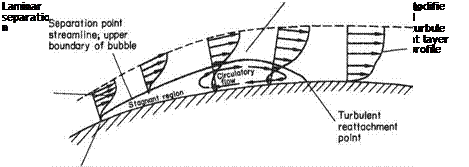Separation bubbles
On many aerofoils with relatively large upper-surface curvatures, high local curvature over the forward part of the chord may initiate a laminar separation when the aerofoil is at quite a moderate angle of incidence (Fig. 7.14).
Small disturbances grow much more readily and at low Reynolds numbers in separated, as compared to attached, boundary layers. Consequently, the separated laminar boundary layer may well undergo transition to turbulence with characteristic rapid thickening. This rapid thickening may be sufficient for the lower edge of the, now-turbulent, shear layer to come back into contact with the surface and re-attach as a turbulent boundary layer on the surface. In this way, a bubble of fluid is trapped under the separated shear layer between the separation and re-attachment points. Within the bubble, the boundary of which is usually taken to be the streamline that leaves the surface at the separation point, two regimes exist. In the upstream region a pocket of stagnant fluid at constant pressure extends back some way and behind this a circulatory motion develops as shown in Fig. 7.14, the pressure in this latter region increasing rapidly towards the re-attachment point.
Two distinct types of bubble are observed to occur:
(i) a short bubble of the order of 1 per cent of the chord in length (or 100 separation – point displacement thicknesses*) that exerts negligible effect on the peak suction value just ahead of the bubble.
(ii) a long bubble that may be of almost any length from a few per cent of the chord (10 000 separation displacement thicknesses) up to almost the entire chord, which exerts a large effect on the value of the peak suction near the aerofoil leading edge.
It has been found that a useful criterion, as to whether a short or long bubble is formed, is the value at the separation point of the displacement-thickness Reynolds number Rep — Ue6*/v. If Rep < 400 then a long bubble will almost certainly form,
 |
Fig. 7.14
Displacement thickness 6* is defined in Section 7.3.2.
while for values >550 a short bubble is almost certain. In between these values either type may occur. This is the Owen-Klanfer[36] criterion.
Short bubbles exert very little influence on the pressure distribution over the aerofoil surface and remain small, with increasing incidence, right up to the stall. They will, in general, move slowly forward along the upper surface as incidence is increased. The final stall may be caused by forward movement of the rear turbulent separation point (trailing-edge stall) or by breakdown of the small bubble at the leading edge owing to failure, at high incidence, of the separated shear flow to re-attach (leading-edge stall).
If a long bubble forms at moderate incidence, its length will rapidly increase with increasing incidence, causing a continuous reduction of the leading-edge suction peak. The bubble may ultimately extend right to the trailing edge or even into the wake downstream, and this condition results in a low lift coefficient and effective stalling of the aerofoil. This type of progressive stall usually occurs with thin aerofoils and is often referred to as thin-aerofoil stall. There are thus three alternative mechanisms that may produce subsonic stalling of aerofoil sections.











